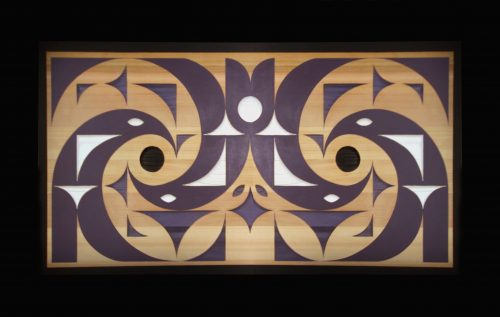 Five Ravens
Five Ravens
.
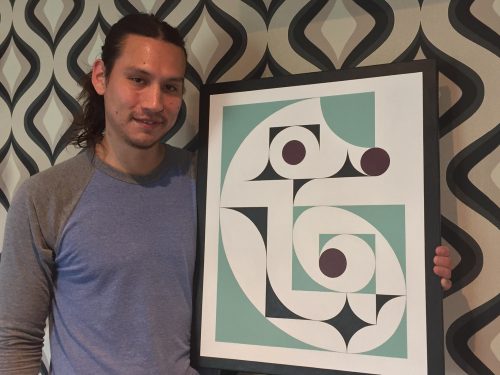
Over the course of recorded history, many profound intellectuals have contemplated the nature of mathematics. Albert Einstein believed that math was nothing more than “a product of human thought,” which caused him to wonder how its principles could seem “so admirably appropriate to the objects of reality.” In contrast, Johan Kepler believed that mathematics was an inherent feature of the Universe, famously stating, “geometry existed before creation.” But regardless of one’s philosophical leanings, it’s obvious that, from the curious perspective of a human mind, Nature seems to be “written in the language of mathematics” (Galileo Galilei).
A few million years before Einstein, Kepler, and Galileo mused about the Universe, the concept of mathematics likely originated from an evolutionary breakthrough that happened before modern humans ever walked the earth. When hominids emerged from their primate ancestors, they gained a powerful ability to recognize patterns in the natural world, which allowed them to comprehend cause-and-effect in a way that had never been achieved by any other species. Their ability to understand and predict patterns of behavior in wildlife allowed hominids to become effective hunters and trappers, despite their relatively weak and slow physiology; their ability to recognize patterns of physical correlation allowed them to manipulate different materials to create novel technologies (e.g. tools, clothing, housing, etc.); and their ability to understand and predict seasonal patterns would eventually lead to the development of agriculture. All of these examples illustrate that hominids’ pattern recognition fostered a myriad of practical evolutionary benefits. But along with these utilitarian advantages, this ability also provided a cognitive foundation for creative expression and this would eventually lead to the earliest known forms of visual art.
In 2014, the Leiden Museum carbon dated a collection of prehistoric cutting utensils found on the Indonesian island of Java. The tools were constructed from mussel shells by Homo Erectus, a primitive species of hominid that is closely related to modern humans. While this technology was relatively typical for the time period, researchers noticed that there was something quite atypical about these tools: some of them were engraved with zigzagging lines and the arrangement of the patterns demonstrated a high degree of intent. With no reasonable inference regarding their practical value, the researchers had to assume that the lines were made for aesthetic purposes. When the tools were tested, the results indicated that the shells were roughly 500 000 years old (300 000 years older than any previously discovered artwork); this suggested that hominids developed conceptual thought much earlier than previously believed. But with regard to mathematics, since these artifacts were made roughly 400 000 years before any known stone figurines or cave paintings, it also suggested that geometry – not figurative images – inspired the first aesthetic creations.
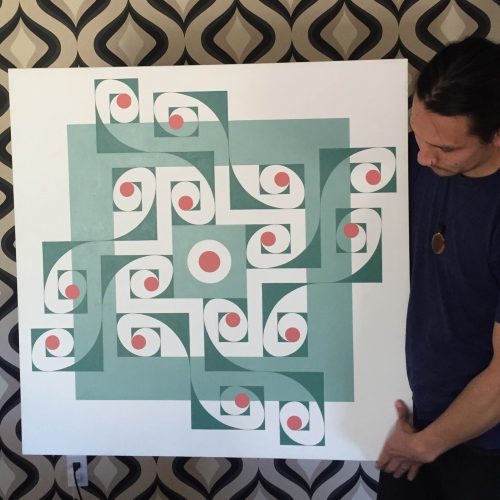
When hominids evolved into modern humans, they developed an ever-growing fascination with Nature. And undoubtedly, as they explored, examined, and experienced their environment, they would have noticed, even before the concept of geometry was developed, that the Universe often structures itself in aesthetically balanced forms. The circle, the pinnacle of balance in geometry, was likely the first shape to capture their attention. The sun and the moon were (and still are) omnipresent features of life on earth, and I imagine that our ancestors would have frequently gazed skyward to appreciate their seemingly perfect form. But Nature’s creations go far beyond the circle: from the radial symmetry of flowers, to the logarithmic spirals of mollusk shells, to the fractal scaling of succulents – geometry pervades the Cosmos. To early humans, these elaborate arrangements must have represented an underlying order, a guiding spiritual force that created and organized the Universe. So unsurprisingly, mathematical arrangements played a significant role in early religious art .
As humans moved out of Africa and spread across the globe, they split into numerous civilizations, all with unique beliefs and practices. But despite their profound diversity, all cultures had some form of visual art, with the vast majority incorporating mathematical arrangements. Some symbols, such as the “flower of life” (a series of overlapping circles arranged to form a floral pattern) and the Pentagram (a five-pointed star made of a continuous line), were found on artifacts from pre-classic Greece (and in all likelihood were developed by earlier tribal civilizations); other symbols are still in use today: Taoism’s “yin yang” (2-fold rotational symmetry), Judaism’s “star of David” (3-fold radial symmetry) and the “Caduceus” (1-fold reflection symmetry) are all ancient geometric forms that have survived through the ages into modernity.
But these techniques were not limited to the “Old World,” and, in the Americas, many indigenous cultures used geometry in their art work – including my Salish ancestors. While Coast Salish culture didn’t create semiotic symbols like many European civilizations, they did create visual art (spindle whorls, rattles, house-posts, etc.) with animal and floral forms that utilized the same geometric techniques found around the world. These design elements have been carried into modern Salish art and have been expanded upon by the contemporary master, Susan Point, and subsequently, by the newest generation of Salish artists, such as lessLie , Maynard Johnny, Chris Paul, and myself.
As I began to study Salish design, I became enamoured with the geometric techniques used by my ancestors. This inspired me to widen my research, and I engaged in an expansive study of traditional geometry in other cultures. In this exploration, I became particularly fond of two styles: the Asian mandala and Islamic tessellations.
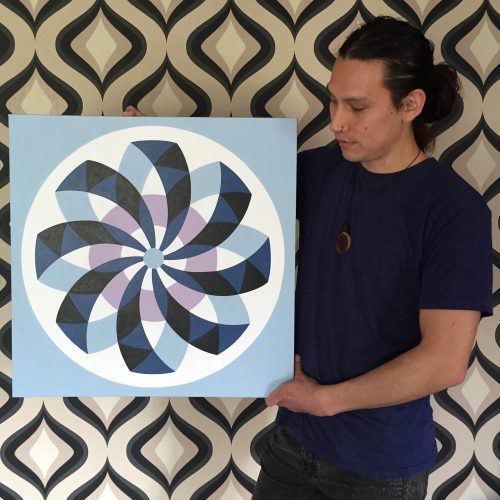
Mandalas are geometric images that represent the Cosmos, which are used as a meditation tool in some Buddhist and Hindu cultures. They traditionally consist of a circle that is enclosed in a larger square with four t-shaped gates, all structured using 2-fold reflection symmetry. Some of these designs show characteristics of fractal geometry – meaning shapes that show similarity at every scale (such as a mandala within a mandala within a mandala etc.). Modified versions of these techniques became an integral part of my artistic style – a style that would eventually lead to the works in Sacred Geometry.
Islamic art has had an equally strong influence on my creative development. Unlike Christianity and Judaism – whose worshippers have a long history of producing depictions of religious figures (e.g. Michelangelo’s “The Creation of Adam” or the Tzippori Synagogue Mosiac), idolatry is considered blasphemous in Islam. As a result, their cultural art diverged from the other Abrahamic religions, and Muslim artists created many unique art forms, such as calligraphy and tessellations. Tessellations are infinitely repeatable patterns consisting of a series of identical shapes (called tiles) that fit together to form a larger design. A checker board is one of the simplest forms of tessellation (a series of identical squares), but Muslim artists took the concept to a remarkable level of complexity. From the 7th century through the entire Middle Ages, in South Asia, The Middle East, North Africa, and Europe, Muslim artists decorated rugs, ceramics, architecture and much more with these awe-inspiring patterns. Using little more than straight lines (a detail that would play a significant role in the development of my exhibit), Muslim artists created intricate designs with interlacing and overlapping polygons and circles that often unite to create star and floral forms. The symbolic value of these tessellations adds the sacred element to the geometry: the circular shapes represent the paradoxical unity and diversity of existence, and the pattern’s infinite nature (i.e., its geometric ability to expand forever) represents the boundless possibilities of the divine realm.
The modern master of mathematical art, M.C. Escher, credited Islamic geometry as the inspiration for his renowned woodblock prints. In 1936, he visited a Moorish mosque in southern Spain and was enthralled by its tessellated architecture. Escher (and at his request, his wife) feverishly tried to sketch the various patterns for later imitation. After this visit, Escher engaged in years of study and practice, until eventually he was ready to reveal his unique twist on the tessellation. But he believed that “capricious patches of abstract geometric figures” would hold “little meaning” for his audience and that his tessellations would only be appreciated if they were recognized as “clear symbols of people, animals, [and] things…” But this is where my artistic intentions diverge from the master.
Considering the artistic era that Escher lived in, it’s not surprising that he had a deep passion for figurative art, which had been a nearly universal convention for centuries prior. But while Escher was developing his geometric style in the 1930s, Modernists were shouting, “make it new,” and developing an aesthetic world space that would transcend the fetters of artistic tradition. The Modernists would, in time, essentially change the definition of fine art, but at the beginning of Escher’s career, these new creative movements were still quite divisive. Taking into account the divided nature of the zeitgeist, mixed with Escher’s formal training in illustration (an extremely figurative medium), it’s easy to understand why his art took its specific form – a form that I’m forever grateful to have known and studied.
But since the 1930s, artistic culture has traveled through a vast range of movements, which, during Escher’s development, had yet to be imagined – one of which being Minimalism. Following the Modernist currents towards Post-Modernity, some artist drifted further and further from the verisimilitude that had dominated art for most of recorded history. And in the early 1960s, some New York City artists – such as Kenneth Noland, Frank Stella, and Ellsworth Kelly – were creating abstract paintings with simple geometric forms that lacked any notion of figurative imagery. Since these artists weren’t overly concerned with imitating objective reality or even representing objective reality through a unique perspective, they were able to focus on the subtle aesthetic aspects of their paintings (such as contrast, weight, balance, orientation, etc.), which created works with an understated but powerful effect. Considering the enduring legacy of these artists, I believe that their work has demonstrated that, contrary to Escher’s opinion, “capricious patches of abstract geometric figures” can be meaningful, if they exist in an appropriate artistic atmosphere. And by abandoning the religious, naturalistic, and humanistic meanings of the past, Minimalist art carries a meaning that, in my opinion, is at the pure center of all creative endeavors, a meaning that has slowly become my primary artistic focus – which is to represent that mysterious and elusive quality known as beauty.
As I continue my studies of visual art, it seems as though the more I learn about aesthetics (i.e. the nuanced details create and emphasize beauty), the less I intellectually understand the concept; this is likely because beauty doesn’t operate on the intellect and is, by nature, not rational. But it wouldn’t be appropriate to call beauty irrational either. A far more accurate term, one used by the philosopher Ken Wilber, is trans-rational, because it seems to operate on something much deeper than the intellect, what some might call the heart or soul or spirit. In my experience, beauty only fully manifests when the intellect subsides, when the mind goes quiet and all “hows” and “whys” disappear. There’s no rational value in gazing at a midnight sky punctured with mysterious light from distant worlds or the radiant spread of red hues rising in a twilight fade from the horizon – but, for me, only the trans-rational aspects of life can give meaning to existence. Or, as Friedrich Nietzsche put it, “We have art so we may not perish by truth.”
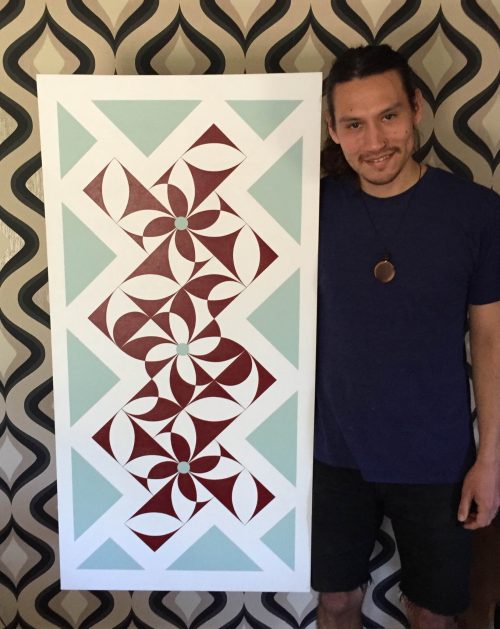
My growing devotion to aesthetics helped me set the parameters for this exhibit: I decided to let my intuitions about geometric beauty guide every creative decision. This meant prioritizing aesthetics over the figurative elements (i.e., animal forms) that I was accustomed to using in my traditional Salish art. Although animal images do appear in a few pieces, those specific designs developed organically – meaning they only took a figurative shape if, in the designing process, it seemed to happen on its own. The appearance of figurative art among these images might be due to some quasi-Pavlovian impulse that developed from years of Salish designing – illustrating that artistic habits, like all habits, also die hard. But regardless of their origin, I’m happy with the results.
In the past, I’ve enjoyed the puzzle-like challenge of arranging animals to fit my aesthetic vision and taste. But the designing process for Sacred Geometry was a refreshing change in my practice. I surrendered control to the mathematics, and with nothing more than a little refinement, the designs essentially built themselves based on the geometric processes I applied. This manner of working felt much more natural than any designing I had done previously – so natural that, more often than not, I hardly felt involved. While the idea might seem cliché and is often perceived as pseudo-spiritual hyperbole, I (and numerous people I have talked to) know firsthand that, in those purest moments of expression, art seems to be created through you, not by you. And I can say, without a hint of exaggeration, that these experiences are the sacred aspect of creating art.
The other constraint I set for myself was to design using only straight lines and circles, a style that I serendipitously discovered while sketching. I loved the idea of creating art with such simple structures – so simple, in fact, that they are almost always the first structures that a child learns to draw. Take, for example, a toddler’s stick figure: it generally consists of a circle head, circle eyes, a half circle mouth to form the obligatory smile, with straight lines creating the torso and limbs. But what, I wondered, would be possible if I restricted myself to these fundamental aesthetic tools? When I first started working with the constraint, I thought that the possibilities would be limited; at most, I hoped to get a small series of designs from the concept. But to my surprise (and ecstatic delight), I found that the potential was much greater than I anticipated. As I experimented, more and more avenues for creation presented themselves, with a surprising range of diversity. Within a month or so, I knew that I had the concept. And, more importantly, I knew that I had discovered a new creative world space that I could return to for the rest of my life.
Some might consider the art in Sacred Geometry more contemporary than my other work, and, in a way, it certainly is. But in another sense, this work is more traditional than anything I have done before – because it draws on a tradition that started before my Salish ancestors ever carved a spindle whorl on the Pacific Coast, a tradition that started before the first human crafted a symbol to honor the earliest conception of God, a tradition that even started before Homo Erectus carved that first pattern into a mussel shell. It’s a tradition that started in the big bang (and according to Kepler, even before), that first moment of creation when, in a mysterious Cosmic exhalation, Spirit took a three-dimensional form and started building the Universe according to timeless laws of geometry.
—Dylan Thomas
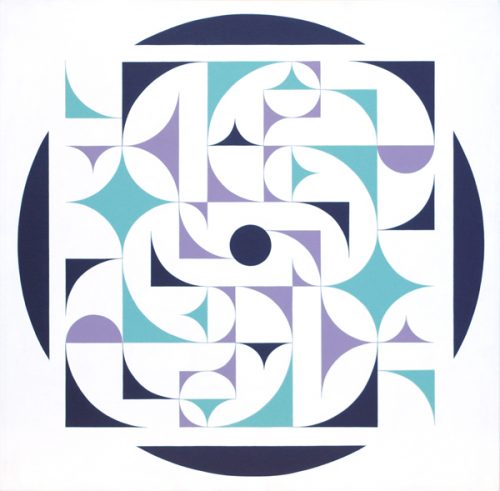 Brave New Whorl
Brave New Whorl
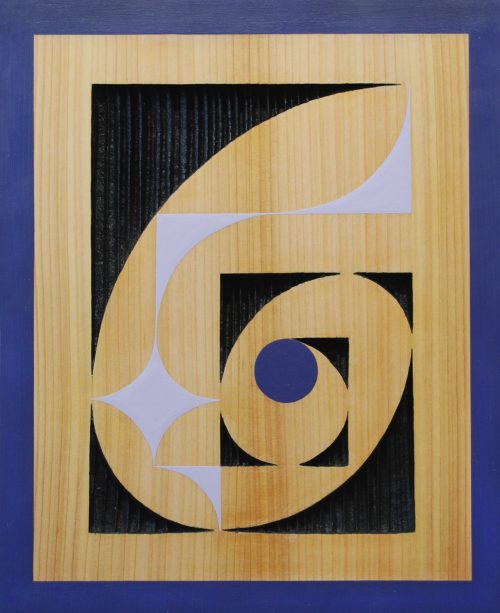 Nautilus
Nautilus
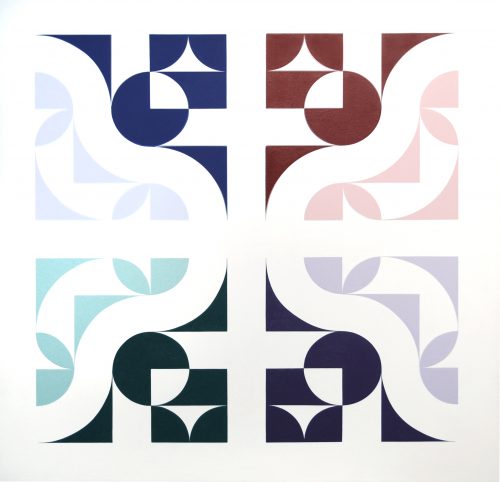 Spectre
Spectre
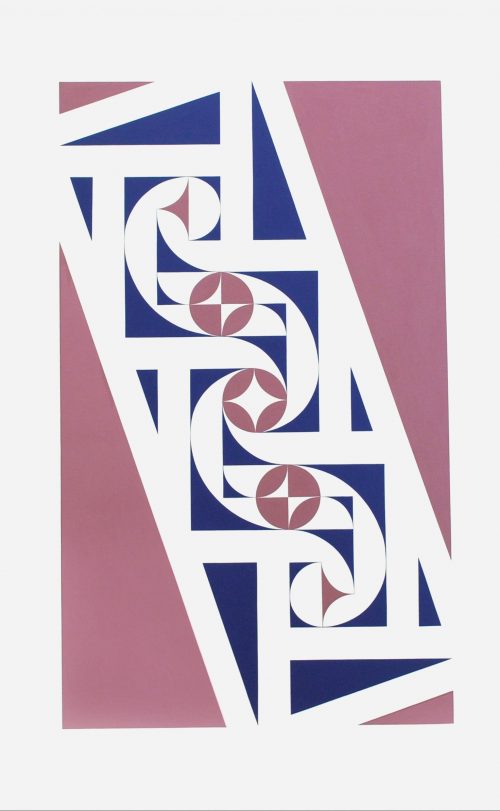 Tipping Point
Tipping Point
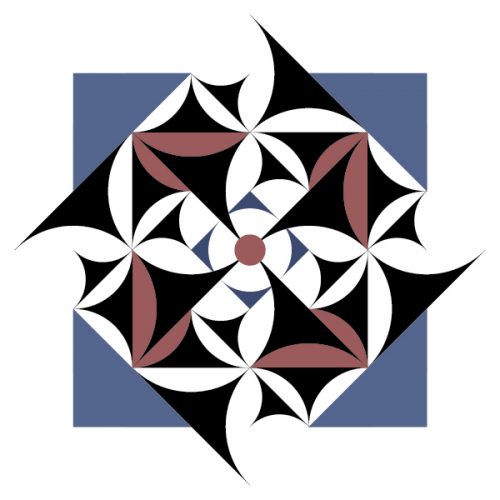 Transcendence
Transcendence
 Butterfly
Butterfly
.
Born in Victoria, in 1986, Qwul`thilum (Dylan Thomas) is a Coast Salish artist from the Lyackson First Nation, originally from Valdes Island. Dylan was exposed to the art at a young age because his family continues to participate in their culture and tradition. He has trained in jewelery with Seletze (Delmar Johnnie) and has apprenticed under Rande Cook in all mediums of the art. Rande has also been a major help in the development of Dylan`s design. His other artistic influences have been late Art Thompson, Susan Point and Robert Davidson.
The images reproduced here were originally produced for Thomas’s first solo show at the Alcheringa Gallery in Victoria, British Columbia, which opened in August.
.
.
These are just wonderful, Dylan.
this is the most astonishing geometry art i have seen. every form is complete. itis like there are platonic solids and salish solids. equally profoundly resonant fractal forms. profound work. and an amazing narrative . lots to ponder.